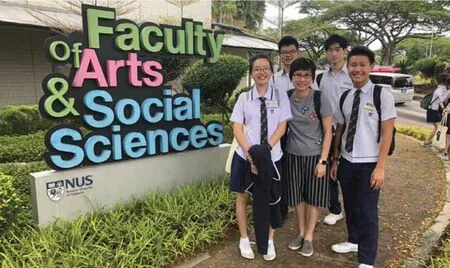RULES OF ATTRACTION Southeast Asian universities emerge as a new choice for Chinese students
By Liao Bowen

Campus of the National University of Singapore.
After graduating from college in China, Zhuo Ming packed his bags to head overseas. After earning a bachelor's degree from Beijing Foreign Studies University in 2019, he was accepted to a graduate program at National University of Singapore (NUS). “I majored in Malaysian, which gives me an advantage in the field of Southeast Asia research,” explained Zhuo. The NUS is the top institution for such research in the world after its extensive work on Southeast Asia related studies. For such students, the decision to venture southeast for graduate school is becoming a no-brainer.
Furthermore, more affordable tuition, an immersive English environment and a smaller cultural gap are attracting more and more Chinese college students to choose Southeast Asia for exchange and further studies.
In October 2009, the “China-ASEAN Double 100,000 Students Mobility Plan” was launched, aiming to facilitate exchange of that many students from both sides by 2020. As a matter of fact, the total amount of students studying on each other's side already exceeded 200,000 by 2016. Through more extensive and closer cultural exchanges between China and ASEAN, the figure continues growing each year.
Quality Education for a Quality Work Force
The NUS and Nanyang Technological University (NTU), two leading Southeast Asian colleges, have been particularly adept at attracting Chinese students. In The Times' annual ranking of higher education in Asia in 2019, NUS held on to the top spot. On the list of the World's Best Universities compiled by QS for 2020, NUS and NTU were tied for 11th.
Many Southeast Asian institutes of higher education have evolved to become world-class. Reputed universities like NUS and NTU emphasize creative, analytical and problem-solving skills while offering professional qualification courses in many different areas of higher education.
“Another reason for my choosing the NUS is the generous scholarship covered by its research funds,” added Zhuo. “My scholarship covers tuition and provides me a monthly allowance which alleviates most of my economic concerns.”
Zhuo Ming previously also considered master programs in UK and US, but colleges there rarely offer scholarships for international masters students, and even though a scholarship is available, the sum does not help much with steep tuition or living costs.
Zhou considered his choice of Singapore over UK or the US carefully. “Many of my classmates applied to schools in the UK and US,” he revealed. “But studying abroad is a complex decision to make. You have to consider college ranking, subject ranking, personal demands, cost, social environment and a host of other issues. Many underclassmen have been asking me about my plans for Singapore. Southeast Asian countries share a similar culture with China, so Chinese students won't feel very alienated in these countries. Many Chinese students get nervous about fitting in social and foreign student circles in the West, but not so much in Southeast Asia.” Most Southeast Asian colleges teach in English, and Chinese is also a common language. Some colleges in Thailand offer bilingual programs in Chinese and English to avoid the cultural and language shock that often strikes Chinese students studying in the UK and US.
Exchange for Diversity
Alongside NUS and NTU, several other Southeast Asian universities have been improving their overall strength. In The Times' annual ranking of higher education in Asia in 2018, the University of Malaya, the country's top school, reached the top 50 in Asia for the first time. Thailand had 10 universities in the top 350, and the number of Indonesian institutions in the top 50 doubled to four from two in 2017.

A group of students in front of the Faculty of Arts and Social Sciences of the National University of Singapore.
Yu Qi is a student enrolled at the Zhuhai campus of Beijing Normal University who has just completed a semester at the University of Malaya as an exchange student. “When I was a freshman, I knew nothing about Southeast Asian universities—I only thought of the region as a nice vacation place,” admitted Yu. “After I learned about the exchange program and high quality of education and research, I decided to give it a try.”
When Yu Qi had just arrived in Malaysia, she was not so used to the local culture or timetable. In the tropical zone, locals tend to arrange activities in the evening. Contrasting student associations and schools on campus in China, many activities in the University of Malaya are organized based on residential area and units, which enabled her to make many friends with local people.
Zihan, a former exchange student at Gadjah Mada University in Indonesia, considers the experience to have widened his knowledge and broadened his international horizon.
“Studying abroad in college is one of the best experiences you can have,” he opined. “Tuition and living costs in Indonesia are much lower than in UK or US, and the friendly local people helped relieve much of the pressure. I was happy to live and study there. The laidback life and higher value on leisure brought me wonderful cultural shock”.
“The older generations established friendly relations between the two sides, but young people don't know much about each other,” noted Yang Xiuping, former secretary general of China-ASEAN Center. “I hope the younger generation can enhance the friendship between China and ASEAN and pass it on through study, exchange and mutual understanding.” Youth exchange goes both ways. As more and more ASEAN students come to China, the number of students from China visiting ASEAN for exchange and further study is also increasing. As they achieve degrees and acquire knowledge, they will learn about local culture, make friends, spread Chinese values and promote China-ASEAN cultural exchange.
Since 2012, more than 350,000 students from China have studied in “Belt and Road” countries. By April 2017, China had signed 45 bilateral and multilateral cooperation agreements in education with countries along the Belt and Road as well as higher education degree and diploma mutual recognition agreements with 24 countries along the route. In the future, even more Chinese students will visit Southeast Asian and other Belt and Road countries and serve as messengers of cross-cultural communication.
- China Report Asean的其它文章
- SEIZING SUSTAINABLE SOLUTIONS CHINA SETS THE STANDARD FOR ALLEVIATING POVERTY AND PROMOTING ONGOING GROWTH
- RIDING CHINA-ASEAN CULTURAL WAVES EMERGING OPPORTUNITIES FOR COOPERATION BETWEEN CHINA AND ASEAN IN CULTURAL AND CREATIVE INDUSTRIES
- PAGODA CITY Unforgettable memories in Bagan
- CIVILIZATION BEFORE TIME Archaeological Ruins of Liangzhu City named a UNESCO World Heritage Site
- THE BOOK ON CULTURAL EXCHANGE A Chinese-Malaysian publishing MoU sets the stage for extensive cooperation
- CHINESE HIGH-TECH AG IN CAMBODIA New collaboration on harvesting rice and cotton

